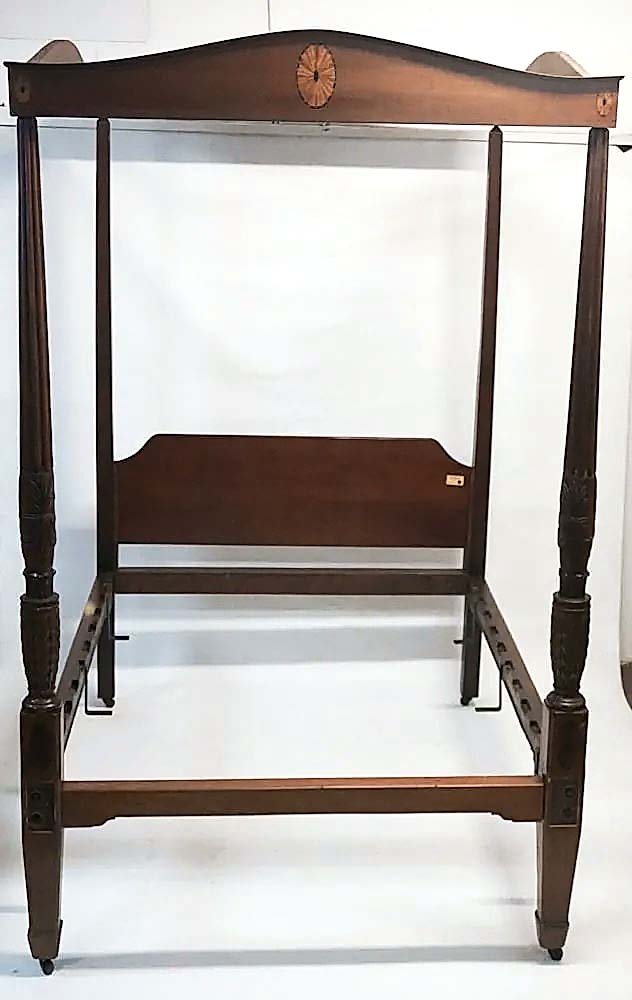
Highlighting the sale was a Charleston carved mahogany rice bed in the Federal style. The first of its kind to be sold by Wooten & Wooten, it achieved $42,000 ($30/50,000).
Review By Caitlyn “Cat” Snell; Catalog Photos Courtesy Wooten & Wooten
CAMDEN, S.C. — Wooten & Wooten rang in the New Year with its January 13 Winter Estates & Collections Auction, which showcased 523 lots ranging from period English and American wooden furniture to Indigenous artifacts to decorative housewares. Interest proved high with 80 percent of lots sold.
The star of the sale was a Charleston Federal carved mahogany rice bed, circa 1790. The classic four posts featured detailed carvings of tassels over tobacco or acanthus leaves and supported a canopy decorated with inlaid oval satinwood medallions. This tester was a later addition by Montgomery Bentz of Charleston, S.C., who is only one name in the thorough provenance of the piece, which traces back to the probable original owners, the Stoneys, a historic Charleston family. Adding to the interest in this lot, it was featured in the second volume of The Furniture of Charleston by Bradford L. Rauschenberg and John Bivins; additionally, it retained 1978 label from the Museum of Early Southern Decorative Arts (MESDA).
Ultimately, the lot brought in $42,000 with the proceeds of the sale benefiting the historic Strawberry Chapel Church of Moncks Corner, S.C. Jeremy Wooten, co-owner of Wooten Auctioneers, said of the sale that he was pleased. In particular, on the subject of the period furniture’s performance, he said that “strong American furniture has been holding its value.”
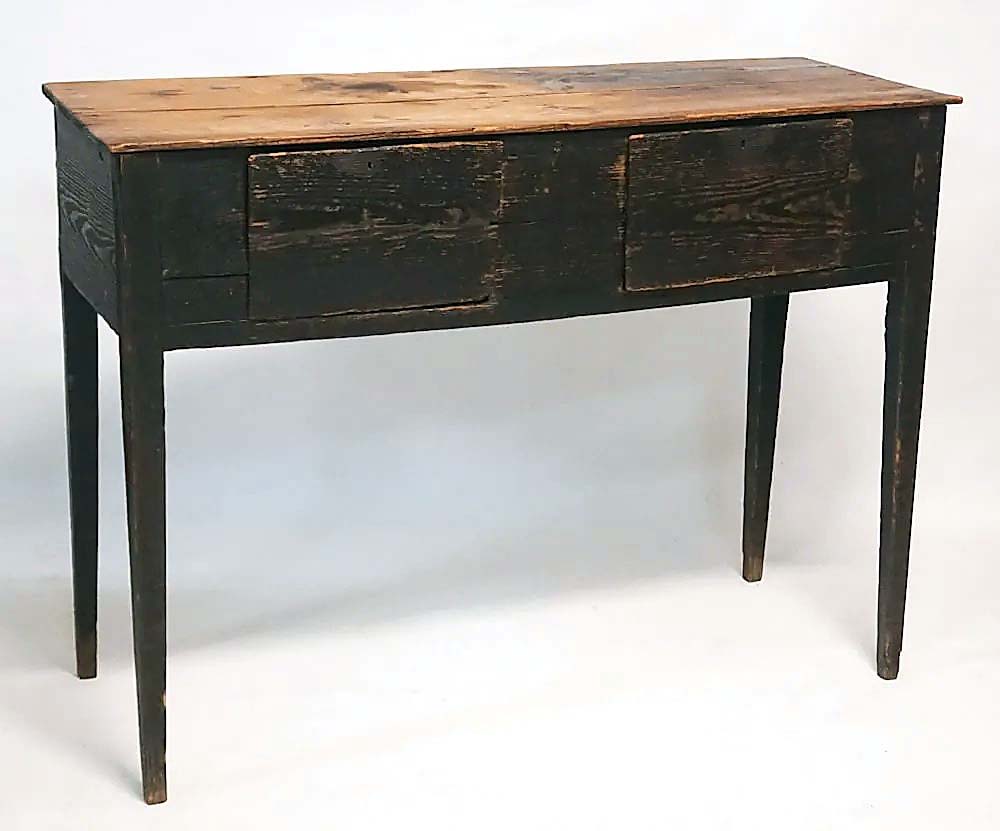
This 1820s Federal yellow-pine hunt board with early paint on surfaces realized $4,500. With a rectangular top and two drawers over four tapered legs, the piece measures 42½ inches tall by 55½ inches wide, and 20½ inches deep ($4/7,000).
Many pieces of fine wooden furniture were among the highest earning lots, particularly those of Southern heritage. One painted Federal huntboard, likely from the midlands of South Carolina, proved competitive, claiming $4,500. Circa 1820 and constructed entirely from yellow pine, it retained its early black paint. From the same year was a Federal secretary bookcase in black walnut that drew attention. Standing more than seven feet tall and exceeding four feet in width, this secretary features a molded crown over its glass-housed shelving. The lowercase housing pulls out into a writing surface with period wrought iron hooks to secure it. It boasted an impressive history with the Rabb family as it has “always been a part of their family inventory,” Wooten said of this piece. The lot’s rare form earned it $3,625.
An Eighteenth Century American Chippendale blanket chest from the South or Pennsylvania also experienced competitive bidding. More than doubling its estimate, the chest claimed $1,560. Inlaid with the initials “HF” and the year “1785” in the center, with tulip inlays to the left and right, Wooten said that it was “a great example of American furniture.”
An Arts and Crafts Stickley Brothers sideboard from Grand Rapids, Mich., rightly earned a high price. The lot is distinct for its clear intentional craftsmanship and distinct attention to detail. It featured a molded top with backsplash over a lower case, including drawers and doors with hammered copper features. Including its original maker’s metal label, the sideboard realized $2,000.
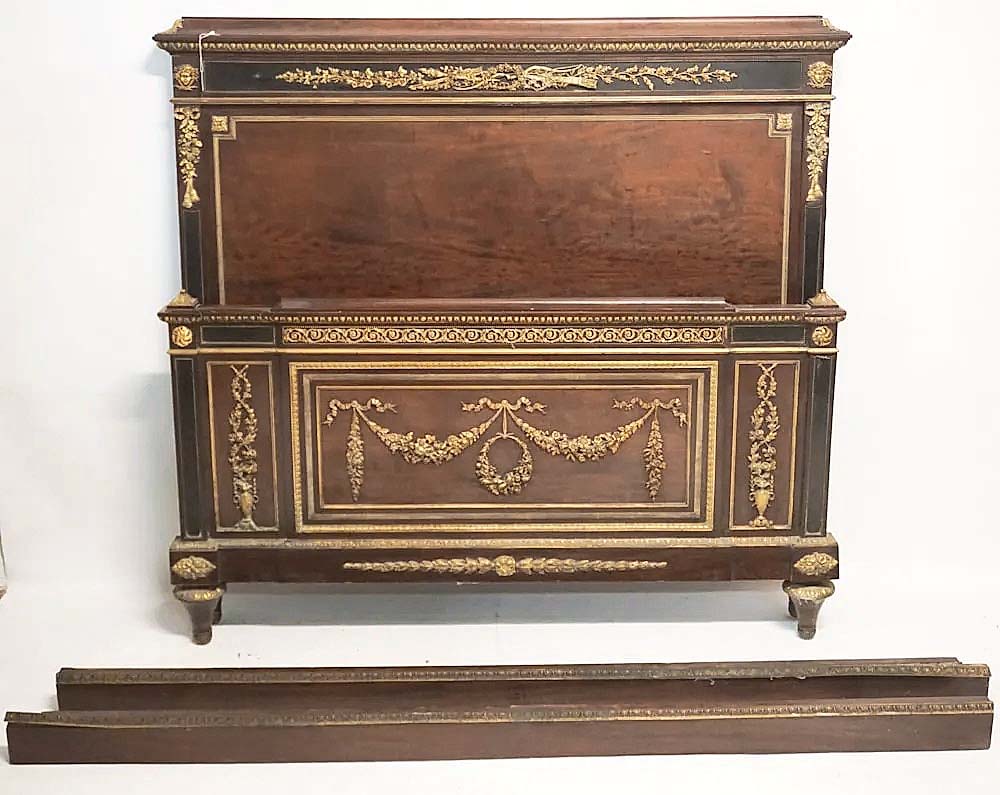
At 57 inches high by 62 inches wide by 91 inches long, this circa 1900 French Louis XVI-style kingwood bed sold for $2,500 ($800-$1,200).
Furniture made outside the United States also performed well. A circa 1900 French Louis XVI-style kingwood bed achieved $2,500, doubling its highest estimated sale price. This item, which is possibly by ebeniste François Linke or a competitor, boasts high-grade bronze casting and gilding throughout its design.
Another gilded work that similarly brought in $2,400 was a late Baroque carved wood chandelier. While likely late Eighteenth Century, this lot was converted to electric for use in the modern home. Constructed entirely of wood with well-cared-for gilding throughout, it is a unique piece, and Jeremy Wooten said it was the first of its kind the auction house had sold.
Decorative and fine art were also represented prominently in the sale, with the second-highest earning lot being an oil on canvas sporting artwork of famed racehorse Saxon (1871-1895), which was painted by Henry Stull in 1882. The painting went to a prominent Ohio collector for $7,800. The horse, which was owned by Pierre Lorillard, won the Belmont Stakes in 1874. Having been purchased previously from art dealer Robert Burger of Mount Vernon, Ohio, the piece has been professionally conserved.
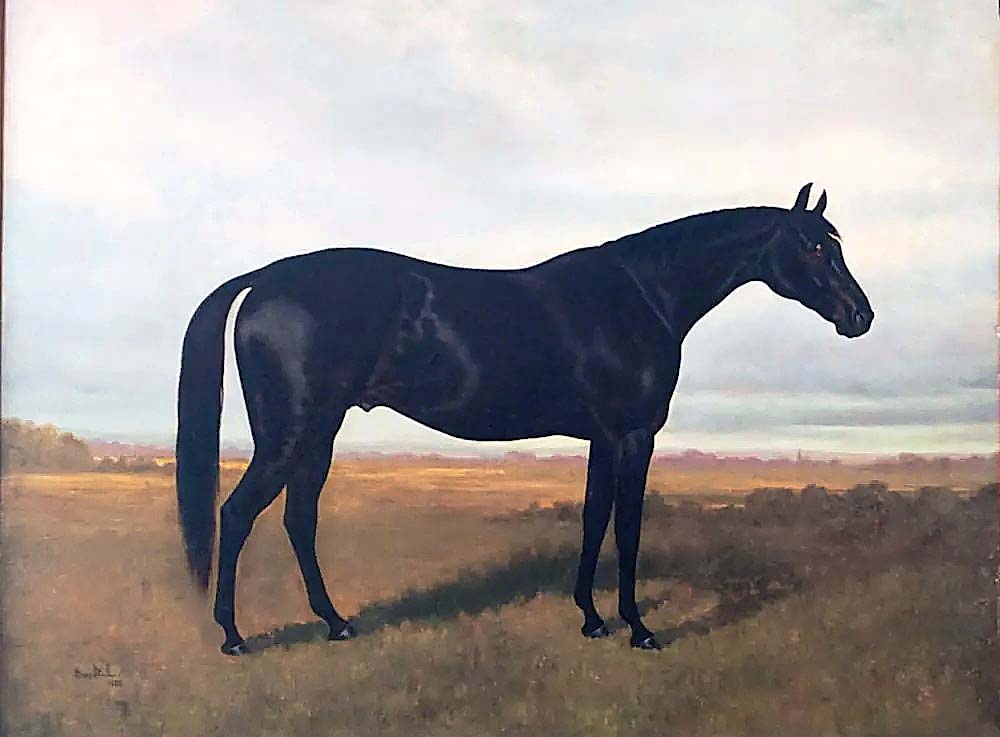
Saxon, a British-bred American-trained race winning thoroughbred, is depicted in this 1882 oil on canvas by Henry Stull (1851-1913) who was active across New York, Kentucky and Ontario, Canada, during his career. The painting earned $7,800 ($10/15,000).
Sculpture was also represented with a lot that featured two pre-Columbian pottery figures likely of Mayan origin. Both figures are seated with decorations throughout, including detailed faces, hands and feet. The age-consistent repairs did not stop this lot from more than tripling its estimate, finally realizing $2,500.
Another North American Indigenous artifact also performed well, Wooten said that they’ve seen something of a “resurgence” in the interest of Native American artifacts. One woven Navajo textile quadrupled its estimate earning $2,160. This pictorial piece which is either a blanket or a rug is 68½ by 42¼ inches and is from the early to mid-Twentieth Century.
For those with an eye on mid-Twentieth Century pieces, an array of items from the era were among the highest earners, including a Patek Philippe 18K gold wristwatch. In excellent condition, the Geneve timepiece is fitted onto a leather band and still runs when wound. Achieving $1,680, the wristwatch was the higher earner of two Patek’s sold, the other being stainless steel on a striking pink band which also claimed $1,680.
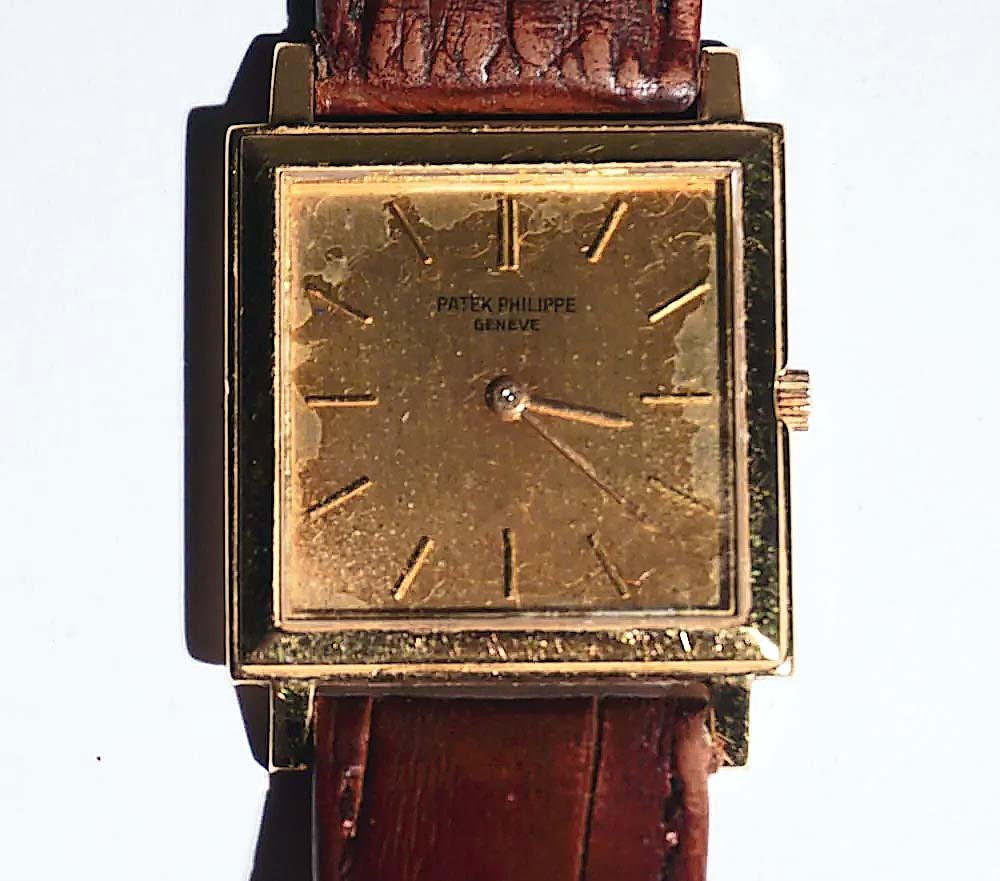
Closing at $1,680 was this still-working vintage Patek Philippe 18K gold wristwatch ($1,5/2,000).
Two Midcentury Modern furniture sets were also sold; both came from the collection of Number One King Street alongside many other top sellers. The sellers, known for their traveling and the breadth of their collection, offered an upholstered rosewood set, including two armchairs and a settee which brought $2,250. The set featured beautiful lamination and a visually interesting design with curved lines. In a similar style, a Knoll furniture dining room table and chairs crossed the podium. With excellent caning on all eight seats and each signed underneath by Knoll, this set went for $2,125.
Decorative arts of all kinds sold well. A rare “E” stamped stoneware jar claimed the title of the third highest selling lot. The unidentified E stamp lent some mystery to this item. Wooten has only come across three similarly-signed sets in his career, and there is still debate over what the E is meant to represent. Going for $4,500 and dated to circa 1825, the jar is an early example of Pottersville stoneware encircled in beautiful runs and some kiln blisters. It also has garnered attention as an Edgefield, S.C., piece, an area that Wooten has seen increasing interest in.
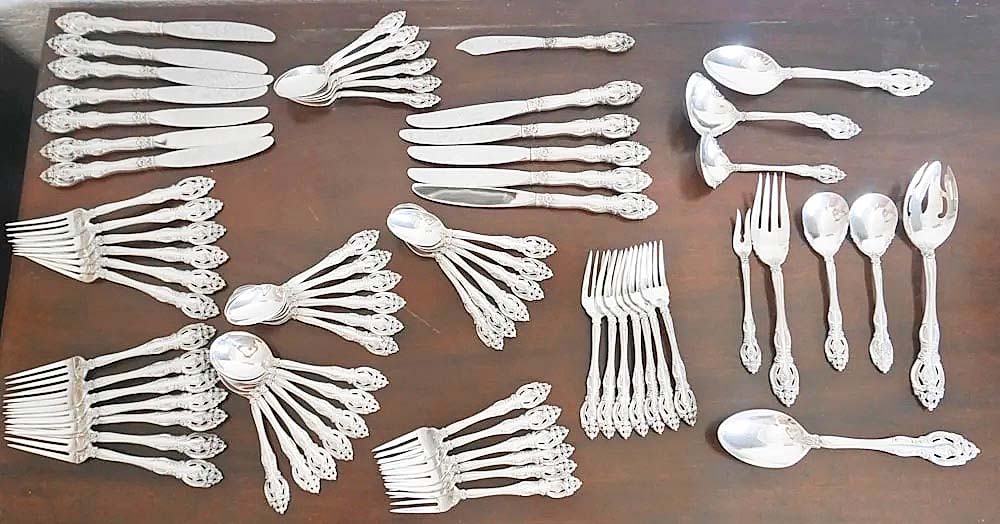
A set of Gorham sterling silver flatware service in the La Scala pattern that totaled 4,101 grams with knives sold from the collection of a Georgetown, S.C., gentleman and lady for $2,280 ($3/6,000).
Two sets of silverware went for competitive prices. An unmonogrammed Wallace sterling flatware service in the popular Grand Baroque style weighed in at 3,516 grams without the knives; the set achieved $2,500. A Gorham sterling silver La Scala flatware set weighed in at 3,213 grams without knives, and sold for $2,280.
All prices include buyer’s premium as reported by the auction house. The firm’s next sale will take place on March 16 and will feature more Southern antiques from North and South Carolina collections. For more information, 866-570-0144 or www.wootenandwooten.com.




















